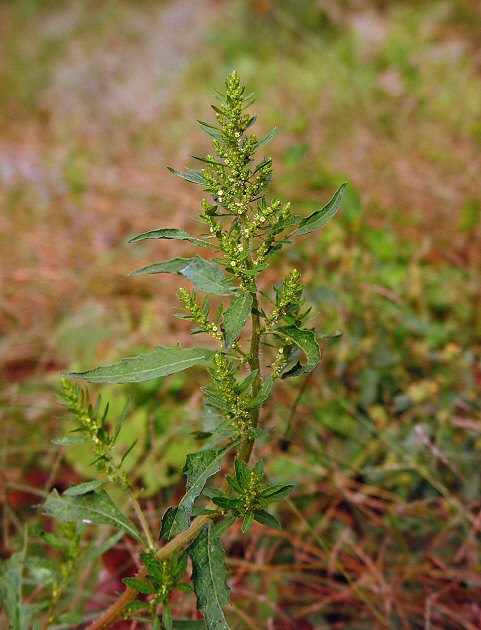Chenopodium ambrosioides L.
Mexican Tea

Introduced
CC = *
CW = 5
MOC = 49
© DETenaglia
Chenopodium ambrosioides L.Mexican Tea | |
 |
Introduced CC = * CW = 5 MOC = 49 |
© DETenaglia |
|
Family - Chenopodiaceae Habit - Annual forb with distinct odor. Stems - Spreading to ascending, to 1 m, usually much branched, with sparse to moderate sessile yellowish glands, sometimes tinged or striped with red.
Leaves - Simple, sessile (uppermost) to long-petiolate (lowermost). Leaf blades mostly 5-14 cm long, those of well-developed leaves mostly 2-5 times as long as wide, linear (uppermost leaves) to oblong, lanceolate, or ovate, bluntly to sharply pointed at the tip, rounded or angled at the base, entire to irregularly lobed, yellowish green to green and herbaceous in texture, the margins often also somewhat wavy or with shallow, irregular, narrow teeth, the surfaces lacking hairs and mealiness, but with sparse to moderate, sessile, yellowish resin glands. Venation noticeably branched, often with 3 main veins from the base.
Inflorescence - Axillary and terminal spikes, the terminal ones sometimes arranged into small panicles, the spikes relatively short and dense, with small clusters of flowers. Flowers not all maturing at the same time.
Flowers - Calyx 5-lobed to below the midpoint, covering the fruit at maturity, the lobes 0.7-1.0 mm long, ovate, bluntly pointed at the tip, flat to rounded dorsally, glabrous or with sparse to moderate, short, fine, nonglandular hairs. Stamens 5. Stigmas 3.
Fruits - 0.6-1.0 mm long, ovoid, the seeds positioned horizontally or vertically, the wall thin, papery, and somewhat translucent, smooth to finely wrinkled, easily separated from the seed. Seeds reddish brown to dark brown, shiny, smooth to faintly wrinkled, rounded along the rim.
Flowering - July - November. Habitat - Crop fields, river banks, dumps, fields, railroads, roadsides, open disturbed areas. Origin - Native to tropical America. Lookalikes - Numerous species of Chenopodium and Amaranthus. As a group these are notoriously difficult to identify to species. Other info. - This aromatic species can be found scattered throughout most of Missouri, and occurs in most states within the continental U.S. Among the Chenipodes it is relatively easy to identify due to its pronounced scent and conspicuously and coarsely toothed leaves. The plant is normally glabrous but pubescent individuals are not uncommon. Photographs taken in Vero Beach, FL., 2-13-03, and off Lee Rd 54, Lee County, AL., 10-8-04. |